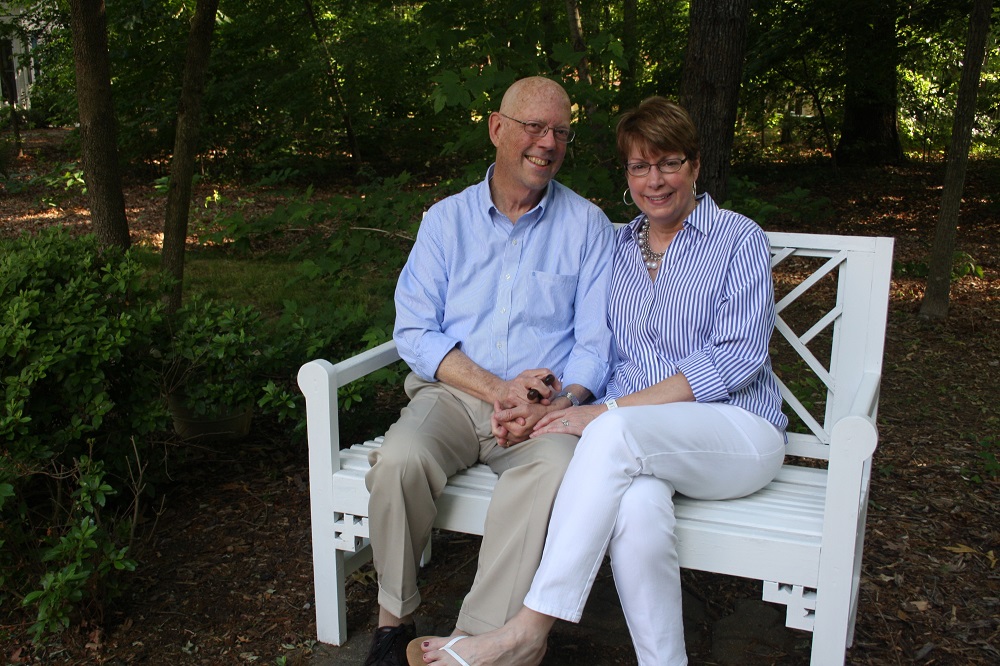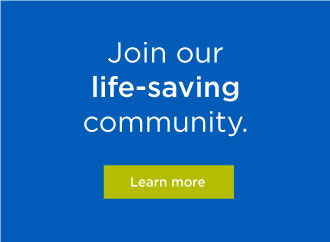During my 40 years as an Obstetrician/Gynecologist I delivered over 5000 babies and threw away almost all of their cord blood as medical waste. I had no clue how valuable it is! I collected about a half dozen units for private banks at the patient’s request but had no knowledge of public cord banking.
Then my life was saved by just four ounces of liquid--stem cells donated by two generous and caring families to a public cord blood bank.
In 2012, I had reduced my private practice to part-time and concentrated on getting into better shape by jogging daily. The week before Thanksgiving while walking with my wife Charlotte, I became short of breath and my heart was racing, something I had not experienced earlier. Lab tests, followed by the first of seven bone marrow biopsies, revealed I had acute myeloid leukemia (AML) with FTL-3 mutation. I was anemic with extremely low white count. Even with my medical education, I had no idea of the scope of treatment that would be needed to fight this disease.
I was admitted to Wake Forest University Medical Center the next week and we spent the next seven weeks in isolation as I dealt with the side effects of two courses of chemotherapy. Chemo-brain is real, for out of the five books I brought with me, I read only one chapter and I slept more than 18 hours a day while living in a fog. We achieved remission, but I was told that without a bone marrow transplant my chance of remission-free survival was only 5-10%.
Maintenance chemotherapy kept my disease in remission through the spring while we searched for a match. As on only child, the best option for me would be an unrelated donor. The search began through the Be The Match Registry®. Despite there being 22 million potential donors, there was not one available as a good match for me. What a disappointment, until we were told of the possibility of a cord blood transplant. How ironic that something I had thrown away so often was now the hope for my survival!
Compared to adult stem cells, cord blood has many advantages. It is stored and ready for rapid use. Mismatches are better tolerated, giving difficult to match patients a better chance for life. Cord blood stem cells offer excellent anti-leukemia effect with much lower rates of relapse and a lower risk of graft-vs-host disease (GVHD).
A search for cord blood began in January and in April we learned two units had been located and that I would receive treatment and transplant at Duke University Medical Center beginning in May. No one can make this journey alone; you must have a dedicated caregiver with you at all times. My wife Charlotte was by my side every step of the way and from then on, the fight became “we” not just “me”. Following 10 days of chemotherapy and total body radiation to destroy my bone marrow and immune system, I was ready for transplant. May 29, 2013 was my Rebirth-day, when I received cord blood units from two different states—just two bags plugged into my IV line. After all the preparations this seemed like an anticlimax.
However, things were not so simple. On the morning of my transplant, with no immunity remaining, I experienced hard chills, a fever of 104, and went into a coma from septic shock. A code was called and the room filled with medical personnel. Thankfully their efforts brought me back from the edge of death. The stem cells had been thawed and were ready for transplant. Without them I would not survive. Thankfully, in spite of the infection, they worked. Intensive therapy helped me recover, but then I fought a bowel obstruction requiring 11 days of NG suction, and we came within just one day of having major surgery, with a very high risk of mortality.
On June 23 we finally graduated to an apartment and went to “Bone Marrow Day Camp” each day for labs, meds and transfusions. The days were not always smooth; we fought CMV infection, acute GVHD, G.I. symptoms, liver and kidney failure and neuropathy. Over the years I had donated over three gallons of blood to Red Cross; I got it all back and more! My appetite was gone, and I had always loved to eat!! Nothing would go down except protein shakes. I lost a total of 85 pounds over nine months of treatment, and was diagnosed with failure to thrive, requiring readmission, tube feedings, endoscopy and steroids.
We started our journey with five men and their families, and we became close friends. Sadly, one man did not make it, leaving behind a young wife and three small children. Finally, steroids helped me turn the corner, and my first meal from an Italian restaurant was delicious!
Charlotte was always by my side—my caregiver, my advocate—she kept my spirits up, and was often my drill sergeant. Her journey as a caregiver may have been more difficult than mine, as she fought sleeplessness, isolation, stress and worry about our future.
After 121 days we finally traveled home to Salisbury, where we remained isolated for several months. Physical therapy helped me rebuild my strength and balance, and I gradually returned to a “new normal”. It is said that “old doctors never die; they just lose their patients.” After a year and a half, and at 66 years of age, I did not return to my practice. But our lives have been very full and rich. Our grandson Jason Miguel is now 10 years old and we are Mimi and Papa to our granddaughter Savannah, who is a 2½-year-old bundle of energy. We love being active in our church and volunteering in our community, and my life is filled with music, singing and playing bass guitar.
In most cases, one year after transplant, recipients can get in touch with their adult donor. But as a cord blood recipient, I can never learn who the donors were or personally thank them. I can only try to pay this wonderful gift forward. So I am an Ambassador with Be The Match® and spread the word about the value of cord blood. We are Peer Counselors for those who are beginning this journey. As a member for the CIBMTR (Center for International Blood and Marrow Transplant Research®) Institutional Review Board, I help protect the safety and privacy of participants in transplant research. During national speeches, I have been privileged to meet giants in the field of cord blood research. And…when our granddaughter Savannah was born, her parents donated her cord blood to our local public bank. We sincerely hope it can save a life, just as someone saved mine.
The world is a very small place. In 1988, the very first recipient of a cord blood transplant was Matthew Farrow, a five-year-old boy who had Fanconi anemia. Joanne Kurtzberg, MD of Duke Medical Center coordinated his care and transplant in Paris, France because the procedure was not yet approved in the U.S. Matthew grew up in our hometown of Salisbury, NC and his mother Shirley was a nurse in my Ob/Gyn practice. 25 years later, Dr. Kurtzberg’s team helped my find my own miracle.
More than 70 diseases are currently being treated by cord blood transplant and research is expanding this number every year. They include blood cancers like lymphoma, immune deficiency diseases, sickle cell anemia and thalassemias, immune and metabolic diseases. Research is exploring treatments for cerebral palsy, autism, diabetes, heart and joint disease, Parkinson’s, stroke and spinal cord injury.
Unfortunately, less than 30% of the community knows anything about cord blood banking, and most only know about private banks. In the United States, 4 million babies are born each year, and less than 5% of their cord blood is saved for either private or public banking. The rest is thrown away as medical waste.
My new life started seven years ago and is completely different from my old one. This experience changed my entire outlook; I was once focused on work and personal issues. But now I am thrilled to wake up to each new day. After my transplant, my purpose in life is to pay this amazing gift forward; to love and help others, to lend a helping hand, to walk alongside someone during tough times.
I see nature's beauty, especially through the eyes of our grandchildren. I appreciate the importance of friends and family and good health. We often hear about experiences that people have when they are near death. During my coma I felt warm, comforted, secure and safely held, happy in God’s presence, all anxiety and fear taken away. Since then, all I have felt is gratitude.
It is said that angels are all around us. I encountered angels every day—from the doctors and nurses who treated me and the cleaning lady who sang to us—to friends and family who were constantly praying for me, calling and sending cards.
My closest angel was my wife, Charlotte, who has been with me for 53 years. She dragged me out of bed each day, made me eat and made shakes when I could barely take a bite, walked me around the block when I could hardly stand and who kept me sane and loved.
But my greatest angels are two caring families who, without ever knowing the miracle they provided, donated their babies' cord blood to public banks. I wish with all my heart that I could personally thank them, but I will never be able to know who they are. All I can do is try to pay that gift forward by spreading the word and encouraging cord blood donation.
We need you to join us and be champions for cord blood. Your efforts make miracles possible each day. With your help, each time a baby is born is a chance to Give Life Twice. To give the Gift of TIME.
TIME to enjoy friends and family.
TIME to watch children and grandchildren grow and explore.
TIME to refocus and be more productive, and more caring.
TIME to develop relationships with God and our fellow man.
And the gift of joy! Our years with our grandchildren have made every step of our journey worthwhile!
We invite you to join us in spreading the word and making cord blood donation the standard of care.


